- Submissions

Full Text
Archaeology & Anthropology:Open Access
Factors Controlling Detrital Mineral Composition of the Sandstones of Khardeola Formation (Meso- Neoproterozoic), Chittaurgarh, Southeastern Rajasthan, India
Shahnawaz1*, Abdullah Khan1, Masroor AM2, Samsuddin Khan1 and Masud Kawsar1
1 Department of Geology, Aligarh Muslim University, India
2 Department of Civil Engineering, Aligarh Muslim University, India
*Corresponding author: Shahnawaz, Department of Geology, Aligarh Muslim University, Aligarh, India
Submission: July 02, 2018;Published: October 05, 201858

ISSN: 2577-1949 Volume3 Issue2
Abstract
The Khardeola Formation (~200m) crops out in the Southeastern parts of Rajasthan, as linear patches in the North-South continuation. The Petrographic data reveal that the Khardeola Sandstone comprises of quartz 72%, as dominant framework mineral, with subordinate amounts of feldspar 12% and rock fragments 6% with some opaque and heavy minerals. The Presence of medium to fine, moderately to poorly sorted and subrounded to subangular detrital mineral suggests that the sediments have not been subjected to prolonged transport and reworking, resulting in only a moderate level of maturity. Diagenetic features observed suggest early cementation, porosity reduction during early compaction by the rotation and readjustment of the detrital grains and formation of linear contacts during mechanical compaction as well as dissolution and replacement of feldspar and lithic fragments at later stage. The petrofacies in Qt-F-L and Qm-F-Lt ternary diagrams suggest that these sandstones mainly belong to the continental block, recycled orogen and rifted continental margin tectonic setting. Thus, the study indicates that detrital mineral compositions are not much affected by the paleoclimate, transportation distance. Source rock composition had dominant control. The Khardeola Formation sediments were chiefly derived from Banded Gneisses Complex (BGC) and metasediments of present day Aravalli Super Group.
Keywords: Petrography; Petrofacies; Provenance; Khardeola formation; Vindhyan basin; Rajasthan
Introduction
The Vindhyan Supergroup occupies a large part of the peninsular India, covering an area of about 104,000Km2 running from Sasaram (Bihar) to Chittaurgarh (Rajasthan), with adjacent states of Madhya Pradesh, Uttar Pradesh, Jharkhand (Figure 1). The Vindhyan Supergroup of India is one of the largest and thickest sedimentary successions of the world, deposited in an intracratonic basin. It is composed mostly of shallow marine deposits. The Vindhyan basin is the repository of the thickest Proterozoic succession in India. The basin overlies the stable Bundelkhand craton of Archean- Early Proterozoic age [1-3]. The investigations by pioneer workers, particularly Heron [4] and Auden [5] have provided authentic information on geology, stratigraphy and regional succession of the Vindhyan accumulated across the basin. These classical, widely distributed assemblages of rocks have attracted a great deal of attention during the last 60 years Prasad [6], Soni et al. [7], Raza and Casshyap [8].
The Vindhyan basin of Rajasthan was geologically mapped and stratigraphy was worked out in detail by Prasad [6], Table 1. Rocks are mainly composed of sandstone, shale and limestone. The basal part consists of volcanic assemblage known as Khairmalia Volcanics or Khairmalia Andesite Formation, which rest unconformably on early Precambrian granite and Banded Gneissic Complex (BGC) [9]. It is overlain by Khardeola Formation that cropped out along the western fringe of Vindhyan basin. The Vindhyan Supergroup is broadly divided into four Groups viz. Semri, Kaimur, Rewa and Bhander from bottom to top.
Geological Setting
The Lower Vindhyan sedimentary sequence is composed of the Semri Group sedimentation is believed to have started sometimes prior to 1721Ma and continued until about ~1600Ma without any major breaks in deposition [10]. The general dip of the lower Vindhyan rocks in this area is easterly and thus the younging of the sequence is towards east [11]. The Lower Vindhyan rocks unconformably overlain by the Upper Vindhyan rocks, but mostly the Kaimur groups overlaps the Lower Vindhyan and directly rests over the Bijawar and/or Aravalli rocks, whereas at some places in Rajasthan, they are seen to overlie the Pre Aravalli rocks, with distinct discordance [6,12]. The Lower Vindhyan either thin or absent in the northwest of the basin. There is a complete sequence of Lower Vindhyan rocks on the western part of the basin in Rajasthan, which comparable and correlatable to the Semri “Series” of the Son Valley area [6,13]. Traditionally the Semri group is considered as Lower Vindhyan, whereas other three groups are categorized under the Upper Vindhyan. The overall lithology is represented by the calcareous, argillaceous and arenaceous sedimentary rocks [14]. Though, the Lower Vindhyan represents broadly clastic carbonate facies with some clastics of volcanics but the upper Vindhyan consist dominantly of sandstone and shale with some minor amount of limestone.
The 200m thick succession of Khardeola sandstone [6] occurs as discontinuous linear ridges and undulating uplands trending North-South, parallel to the existing western boundary of the Vindhyan basin in the district of Chittaurgarh, with regional dips commonly towards east and comprises of a lower assemblage of interlayered fine clastics of (Khardeola shale, siltstone and thin sandstone) and a gritty, coarse to medium grained sandstone in the upper part (Khardeola sandstone) (Figure 1). The Khardeola sedimentation is followed by deposition of the overlying algae dominated Bhagwanpura limestone in a quiet open shelf of transgressive phase [8]; (Table 1).
Figure 1:Geological map of study area along southwestern margin of sickle-shaped pericratonic Vindhyan basin, (A) bounded by Middle Proterozoic fold belts in the west and south; (B) Geological map showing distribution of rocks in the lower part of Vindhyan Supergroup: (1) Khairmalia Andesite; (2) Khardeola Formation (2a) Khardeola shale and sandstone; (2b) Khardeola sandstone; (3) Bhagwanpura Limestone, in the ascending order, the succeeding formations towards east are not differentiated in figure; (C) Dominant subfacies and characters of Khardeola fine clastics, and those of underlying Khairmalia volcanics and overlying Khardeola sandstone and Bhagwanpura Limestone. Insets show the location of the study area in the western part of Vindhyan basin.
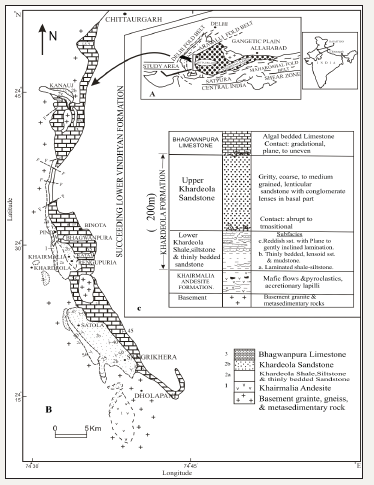
Methodology
Fresh representative samples were carefully selected on the basis of textural and lithological variations and other distinguishable characters from the measurement of five stratigraphic sections exposed at Khardeola, Pind, Katai, Satola and Khairmalia, members of the Khardeola Formation. For petrographic analysis, samples collected at 40-50cm intervals along the entire thickness of the formation. A total twenty representative sandstone samples were analyzed petrographically after etching and stained for calcite, K-feldspar and pore spaces. About 300-350 framework grains per thin section were counted for quantitative analysis and for determining the modal composition of the studied sandstones using the Gazzi-Dickinson method [15], classification and tabulation of grain types.
Varieties of quartz in medium to fine grained quartz population were determined by the method employed by Basu et al. [16]. The quartz grains were counted as undulatory and non-undulatory monocrystalline quartz with 2-3 and >3 crystal unit per grains of polycrystalline quartz. For Qt-F-L and Qm-F-Lt plots, the framework constituents were recalculated to 100% by summing up total quartz (Qt), monocrystalline quartz (Qm), total feldspar (F), all unstable rock fragments (L) and total lithic fragments (Lt= L+Qp) detrital modes following the Dickinson [17].
Table 1:General Stratigraphy of lower Vindhyan succession in parts of Southeastern Rajasthan (after Heron, 1953).
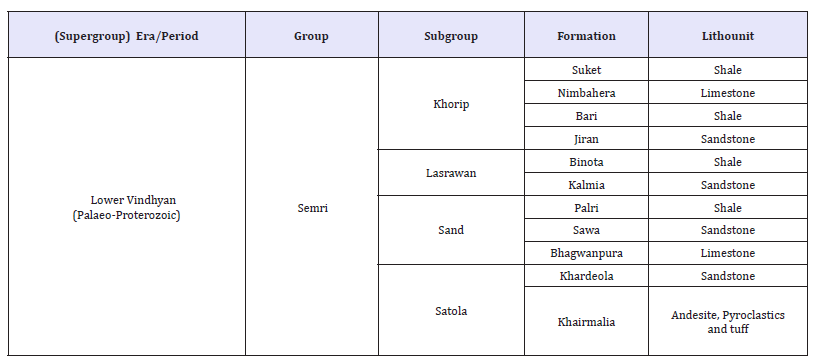
Texture
Khardeola Formation shows medium to fine grained size and moderately to poorly sorting. Mean grain size (Mz) of the studied samples ranges from 0.48Ф to 3.9Ф. Inclusive graphic standard deviation (σ1) ranges from 0.74Ф to 1.45Ф. The sandstones have grain roundness ranging from subangular to subrounded (2.0 to 2.8). An aggregate sample mean roundness value is 3.55. The mean sphericity values of the detrital grains in the studied sandstone range from 0.45 to 0.46.
Sandstone Composition
The mineralogical study of the Khardeola Formation sandstones revealed that the framework constituents of the sandstones are chiefly comprised of quartz (72%), feldspars (12%), rock fragments (6%), micas (2%) and included minor constituents of heavy minerals and opaques. According to Folk’s [18] sandstone classification, the Khardeola Formation sandstones are chiefly Quartzarenites with some Subarkosic and Sublitharenite varieties. Both muscovite and biotite occur in a very small fraction generally less than 2%. The euhedral nature of zircon and opaques in patches observed as heavy framework constituents. These are partially altered occurring in the form of platy and flaky shape. The cements and authigenic constituents in the sandstone are clay minerals (13%), silica (10%) and iron-oxides (3%) in decreasing order of abundance by volume percentage.
Interpretation
Quartz is the chief framework constituents in the studied thin sections. Different varieties of quartz recognized on the basis of Folk’s [18] classification, includes common quartz, recrystallised metamorphic quartz and stretched metamorphic quartz. The monocrystalline and polycrystalline grains both have straight to strongly-undulose extinction. Whereas, polycrystalline quartz posses both sharp to sutured intra-grain boundaries. The ratio of monocrystalline quartz is higher as compare to polycrystalline quartz (Figure 2). In which some of quartz grains are deformed and elongate along which are aligned tiny non-undulatory crystals. The recrystallised metamorphic quartz occurs mainly as polycrystalline composite grains of subequant shape and rang from 1%-4%, with an average about 1.2% (Figure 3A). The feldspars found are mainly plagioclase, microcline and orthoclase with both fresh and altered varieties, often giving rise to sercitization and conversion to clay minerals (Figure 3B). Petrographic study has also revealed that Khardeola sandstones are rich in matrix.
Silica mainly occurs as syntaxial overgrowth around monocrystalline quartz and as silica cement between the framework grains (Figure 3C,3D). Clay minerals in the Khardeola sandstones are regenerated by partial or complete decomposition of the feldspar, and mica grains with slight effect of regeneration (Figure 2 & 4(A-E)). The porosity is greatly influenced by clay mineral and authigenic constituents as average (13%), as they get precipitated between the pore spaces of detrital grains, thereby decreasing the effective porosity of the sandstone. Mode of grain arrangement is another important factor apart from shape and sphericity of the grain in controlling the porosity of the rock. The contacts are predominantly long to concave-convex followed by points, floating and sutured contacts reflecting that moderate to high mechanical compaction, which has prevailed during the diagenesis and burial of sediments, causing a reduction in the porosity and permeability of the rock (Figure 3C). Sorting of the grains is almost poor and has strong control on porosity and permeability of the Khardeola sandstone. Both muscovite and biotite occur as tiny and large, elongated flakes derived possibly from granite, pegmatite or schists. The different kinds of opaques interpreted as magnetite and hematite. Zircon occurs as colourless grains suggest the metamorphic source.
Figure 2:SEM image showing the dissolution of feldspar grain along their cleavage planes.
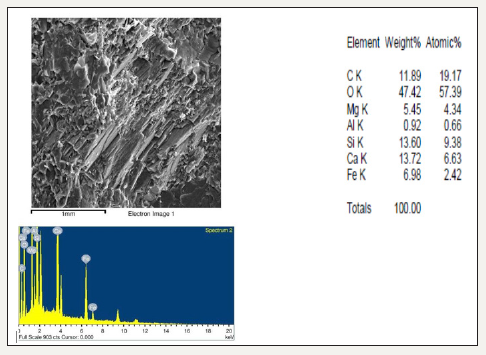
Figure 3:Photomicrograph of Khardeola Sandstones showing:
Figure 3A: carbonate (Cb) cement etched the grains along cleavage (clvg) traces
Figure 3B: overgrowth (ovgth) cements and sutured contacts shows both cementation as well as compaction
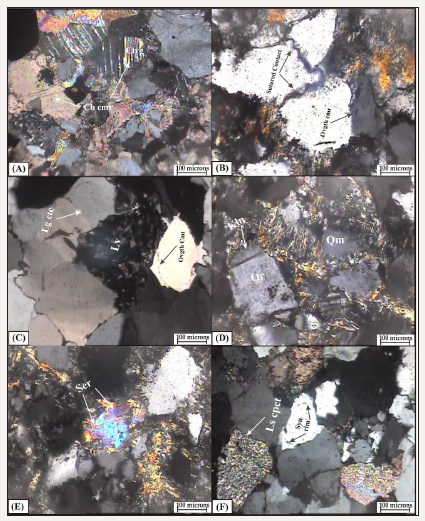
The mineralogical composition and texture of these sandstones as plotted on Q-F-R and Qm-F -Ltreflects their source in the mixed provenance that includes plutonic basement, sedimentary and meta - sedimentary and metamorphic rocks (Figure 4A-4C). However, quartz varieties were plotted on provenance discrimination diagram of Basu et al. [16]. The data mainly lie in the field of plutonic and middle to high rank of metamorphic field (Figure 5), suggest that source area consisting largely of plutonic rocks, which exhibits the exposed roots of magmatic arcs in an older crystalline basement in the area.
Figure 4A:Classification of the Khardeola Formation Sandstone [18], Q-F-R.
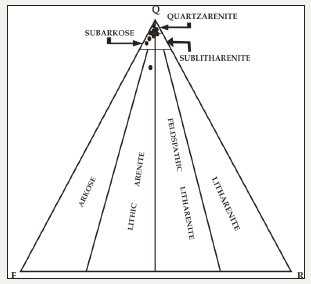
Figure 4B:Classification of the Khardeola Formation sandstone [17], Qt-F-L.
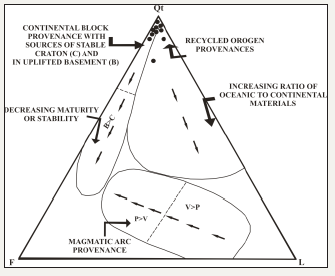
Figure 4C:Classification of the Khardeola Formation sandstone [17], Qm-F-Lt.
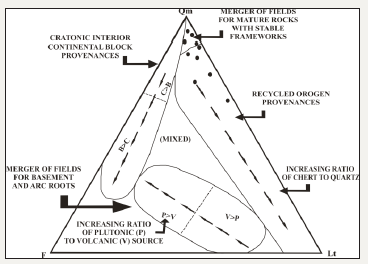
Figure 5:Varietal quartz diamond plot, followed by Basu et al. [16] currently used to discriminate sands sourced by different types of crystalline rocks, on the basis of the extinction pattern and polycrystallinity of quartz grains. Qm non=low-undulosity monocrystalline quartz grains; Qm un=high-undulosity monocrystalline quartz grains; Qp2-3=coarse-grained polycrystalline quartz grains; Qp>3=fine-grained polycrystalline quartz grains.
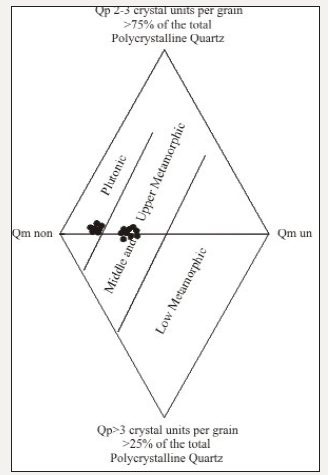
Chiefly sedimentary rock fragments (chert) and low rank metamorphic rock fragments (phyllite and quartzite) observed in the Khardeola Sandstones (Figure 3). Presence of high content of lithic fragments and feldspar concentration indicates that prolonged transportation did not occur from the source area. Diagenetic modification in terms of altered feldspar and deformed unstable, weak lithic fragments suggest that source rocks are suffered by the moderate weathering. On the basis of above analysis it is concluded that, provenance is believed to represent the eroded and weathered parts of the present day Aravalli Ranges, which situated in the western margin of the basin.
Conclusion
The chief constituents of the Khardeola Sandstones are quartz followed by feldspar, rock fragments and heavy minerals. The sandstones of the Khardeola Formation are medium to fine grained, poorly to moderately sorted and angular to subrounded with submature to immature textural and mineralogical character. The chief abundant, quartz is the most common plutonic quartz originated mainly from granitic batholiths or granite-gneisses. Tectonic provenance discrimination diagrams indicate sediment contributed mainly from continental block provenances and recycled orogen. Modal analysis suggested the product of multiple sources, including plutonic basement, sedimentary and metasedimentary rocks, which is believed to be eroded and weathered from parts of s, well represented by granites and granitic rocks of Bundelkhand Craton at one hand as well as by Banded Gneissic Complex (BGC) and Aravalli Supracrustals on the other, situated close by all along the western margin of the basin.
Acknowledgement
Our thanks to Chairman, Department of Geology and Civil Engineering, for providing necessary facilities to carry out this study. We appreciate Prof. V.K. Singh (Deptartment of Geology, Bundelkhand University, Jhansi) for his helpful advice and constructive suggestions during the review of the manuscript. Help during preparation of computer-generated diagrams by Abul Ata, Abdullah, Mohd Sarfaraz Ahmad, of AMU, Aligarh is duly acknowledge.
References
- Bose PK, Sarkar S, Chakrabarty S, Banerjee S (2001) Overview of the Meso- to Neo Proterozoic evolution of the Vindhyan basin, Central India. Sedimentray Geology 141-142: 395-419.
- Chakraborty C, Bhattacharyya A (1996) The Vindhyan basin: An overview in the light of current perspectives. Mem Geol Soc India, pp. 301-312.
- Roy AB (1988) Stratigraphic and tectonic framework of the Aravalli Mountain Range. Precambrian of the Aravalli Mountain, Rajasthan, India. Geol Soc India Memoir 7: 33-75.
- Heron AM (1936) Geology of southeastern Mewar, Rajputana. Mem Geol Surv India 68(1): 1-120.
- Auden JB (1933) Vindhyan sedimentation in Son Valley, Mirzapur district. Mem Geol Surv India 62(2): 141-250.
- Prasad B (1984) Geology, sedimentation and paleogeography of the Vindhyan Supergroup, southeastern Rajasthan. Mem Geol Surv India 116(1-2): 1-107.
- Soni MK, Chakraborti S, Jain VK (1987) Vindhyan Supergroup-A review. In: Purana Basins of Peninsular India (Middle to late Proterozoic). Mem Geol Soc India 6: 87-138.
- Casshyap SM, Bhardwaj BD, Raza M, Singh A, Khan A (2001) Barrier-Inlet and associated facies of shore zone: An example from the Khardeola Formation of Lower Vindhyan sequence of Chittaurgarh: SE Rajasthan. Jour Geol Soc India 58: 97-117.
- Abdullah K, Anis, Shahnawaz, Sarwar R (2013) Petrography, Provenance and Tectonic Setting of Lower Vindhyan Khardeola Sandstones, Southeastern Rajasthan. Gond Geol Magz 28(2): 85-91.
- Ray AK, Tripathy SC, Patra S, Sarma VV (2006) Assessment of Godavari estuarine mangrove ecosystem through trace metal studies. Environmental International 32(2): 219-223.
- Raza M, Casshyap SM, Khan A (2002) Geochemistry of Mesoproterozic lower Vindhyan shales from Chittaurgarh southeastern, Rajasthan and its bearing on source composition, paleoweathering and tectono sedimentary environments. Jour Geol Soc India 60(5): 505-518.
- Prasad B (1975) Lower Vindhyan formations of Rajasthan. Rec Geol Surv India 106(21): 31-53.
- Krishna MS (1968) The geology of India and Burma. Higginbothams, Madras, India, p. 536.
- Srivastava P, Tewari VC (2011) Morphological changes in microscopicmegascopic life and stromatolites recorded during late Paleo-Proterozoic Neoproterozoic transition: the Vindhyan Supergroup, India. In: Tewari VC, Secbach J (Eds.), Stromatolites: Interaction of Microbes with Sediments, Cellular Origin, Life in Extreme Habitats and Astrobiology. Springer Science, USA, 18: 87-114.
- Ingersoll RV, Fullard TF, Ford RL, Grimm JP, Pickle JD, et al. (1984) The effect of grain size on detrital modes: a test of the Gazzi-Dickinson point counting method. Jour Sed Res 54(1): 103-116.
- Basu A, Young SW, Suttner LJ, James WC, Mack GH (1975) Reevaluation of the use of undulatory extinction and polycrystallinity in detrital quartz for provenance interpretation. Jour Sed Petrol 45(4): 873-882.
- Dickinson WR (1985) Interpreting Provenance relations from detrital modes of sandstones. In: Zuffa GG (Ed.), Provenance of Arenites, D Reidel - Boston-Lancaster, USA, pp. 331-361.
- Folk RL (1980) Petrology of Sedimentary Rocks. Hemphill Publishing, Austin, Texas, USA, p. 182.
© 2018 Shahnawaz. This is an open access article distributed under the terms of the Creative Commons Attribution License , which permits unrestricted use, distribution, and build upon your work non-commercially.
 a Creative Commons Attribution 4.0 International License. Based on a work at www.crimsonpublishers.com.
Best viewed in
a Creative Commons Attribution 4.0 International License. Based on a work at www.crimsonpublishers.com.
Best viewed in 







.jpg)






























 Editorial Board Registrations
Editorial Board Registrations Submit your Article
Submit your Article Refer a Friend
Refer a Friend Advertise With Us
Advertise With Us
.jpg)






.jpg)














.bmp)
.jpg)
.png)
.jpg)










.jpg)






.png)

.png)



.png)






